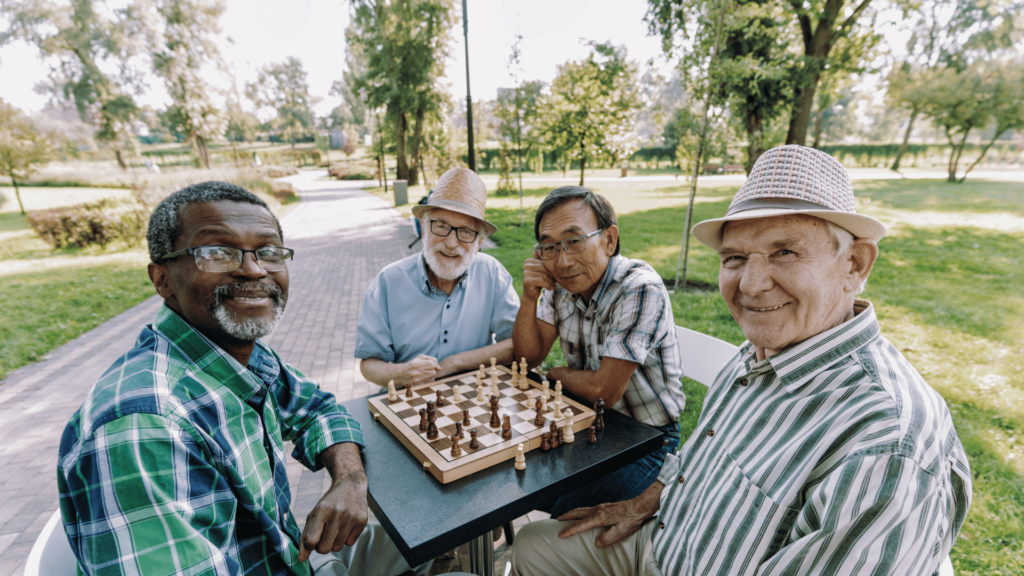Traditions Senior Care Team | January 26, 2025
Creating a Sense of Community
in Assisted Living
Moving to an assisted living community can be a significant life transition. While providing essential support with daily living tasks, a truly exceptional community goes beyond basic care. It fosters a strong sense of belonging, where residents feel connected, valued, and engaged.
This blog post will delve into the multifaceted ways assisted living communities cultivate a vibrant sense of community, exploring the importance of social interaction, engaging activities, and a supportive environment.
The Power of Community in Senior Living
For many seniors, maintaining social connections is crucial for both physical and mental well-being. Loneliness and social isolation can have detrimental effects on health, increasing the risk of depression, cognitive decline, and even physical ailments.
A thriving community within an assisted living setting offers a powerful antidote to these challenges. It provides opportunities for:
- Meaningful Social Interaction: Residents can connect with peers through shared meals, social gatherings, and community events.
- Reduced Social Isolation: The constant presence of others fosters a sense of companionship and belonging, combating feelings of loneliness.
- Enhanced Quality of Life: Social interaction contributes to improved mood, increased cognitive function, and a greater sense of purpose.
- Improved Physical Health: Social engagement can encourage physical activity, improve sleep, and even boost the immune system.
- Emotional Support: Sharing experiences with others provides emotional support and a sense of understanding during life’s transitions.
Key Strategies for Cultivating Community
Assisted living communities employ various strategies to foster a strong sense of community among residents. These may include:
Key Strategies for Cultivating Community
- Social Gatherings: Regularly scheduled events like coffee mornings, afternoon tea, and game nights provide opportunities for casual interaction and social bonding.
- Group Activities: Shared interests can be nurtured through book clubs, art classes, music groups, and exercise classes.
- Special Events: Celebrating holidays and birthdays with community-wide events creates a festive and inclusive atmosphere.
- Outings and Trips: Organized outings to local attractions, museums, and restaurants provide opportunities for residents to explore their community and enjoy shared experiences.
Resident-Centered Programming
- Personalized Activities: Communities should offer a diverse range of activities that cater to the unique interests and preferences of each resident.
- Volunteer Opportunities: Engaging residents in volunteer activities within the community can provide a sense of purpose and contribute to the well-being of others.
- Pet Therapy: Introducing therapy animals can provide comfort, companionship, and opportunities for interaction.
Creating Welcoming Common Spaces
- Cozy Living Rooms: Comfortable and inviting common areas should be designed to encourage social interaction and relaxation.
- Dining Rooms: Shared meals provide a daily opportunity for social connection and conversation.
- Outdoor Spaces: Gardens, patios, and walking paths offer opportunities for residents to enjoy the outdoors and connect with nature.
Building Strong Relationships
- Staff-Resident Relationships: Building strong relationships between staff and residents is crucial for creating a warm and welcoming environment.
- Resident-to-Resident Connections: Encouraging resident-led initiatives and peer support groups can foster meaningful connections between residents.
- Family Involvement: Including family members in community events and activities strengthens the overall sense of community.

The Role of Technology in Community Building
Technology can play a valuable role in enhancing community within assisted living settings.
- Communication Platforms: Secure online platforms and messaging apps can facilitate communication between residents, family members, and staff.
- Virtual Connections: Video conferencing can enable residents to connect with loved ones who live far away, reducing feelings of isolation.
- Interactive Technologies: Engaging technologies like interactive games, music therapy programs, and virtual reality experiences can provide stimulating and enjoyable activities for residents.
The Importance of a Supportive Environment
Beyond social activities and engaging programs, a truly supportive environment is essential for creating a thriving community. This includes:
- Respectful and Dignified Care: All residents should be treated with respect, dignity, and compassion by all staff members.
- Individualized Care Plans: Personalized care plans should address the unique needs and preferences of each resident, ensuring their physical, emotional, and social well-being.
- Open Communication: Open and honest communication between residents, families, and staff is crucial for building trust and addressing any concerns.
- Conflict Resolution: Effective conflict resolution strategies should be in place to address any interpersonal issues that may arise within the community.
Benefits for Residents and Their Families
Cultivating a strong sense of community in assisted living offers numerous benefits for both residents and their families:
- Enhanced Quality of Life: Residents experience increased happiness, reduced stress, and improved overall well-being.
- Increased Independence: A supportive community can help residents maintain their independence and autonomy for as long as possible.
- Peace of Mind for Families: Knowing their loved ones are living in a supportive and engaging environment provides peace of mind for families.
- Stronger Family Bonds: Community events and activities can provide opportunities for families to connect with their loved ones and other residents.
Conclusion
Creating a sense of community is not merely a social amenity; it is an essential component of high-quality assisted living. By prioritizing social interaction, offering engaging activities, and fostering a supportive environment, assisted living communities can enrich the lives of residents, promote well-being, and create a truly fulfilling living experience.
Remember that every situation is unique, and the needs of each resident will vary. You may contact us for personalized assistance.
Latest Blogs
The Importance of Male Friendships in Senior Communities
Moving into an assisted living community represents a significant life transition. While…
Maintaining Mental Wellness in Assisted Living
Moving into an assisted living community represents a significant life transition. While…
Strategies for Supporting a Loved One with Dementia or Alzheimer’s
Dementia and Alzheimer's disease present unique challenges, not only for the individuals…



